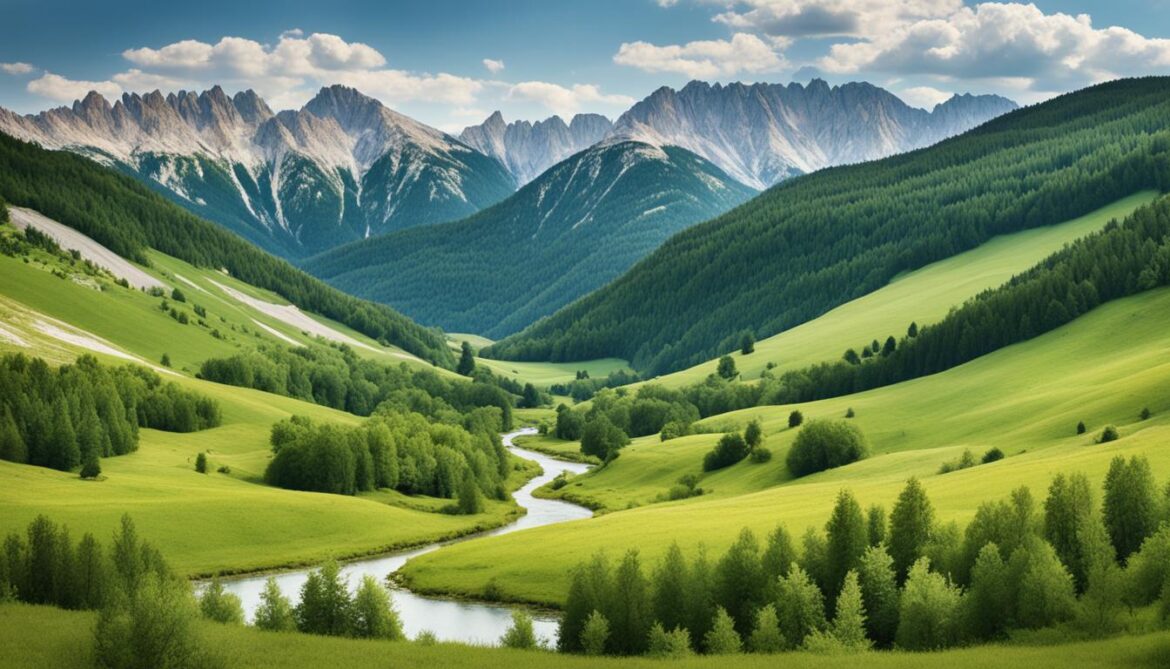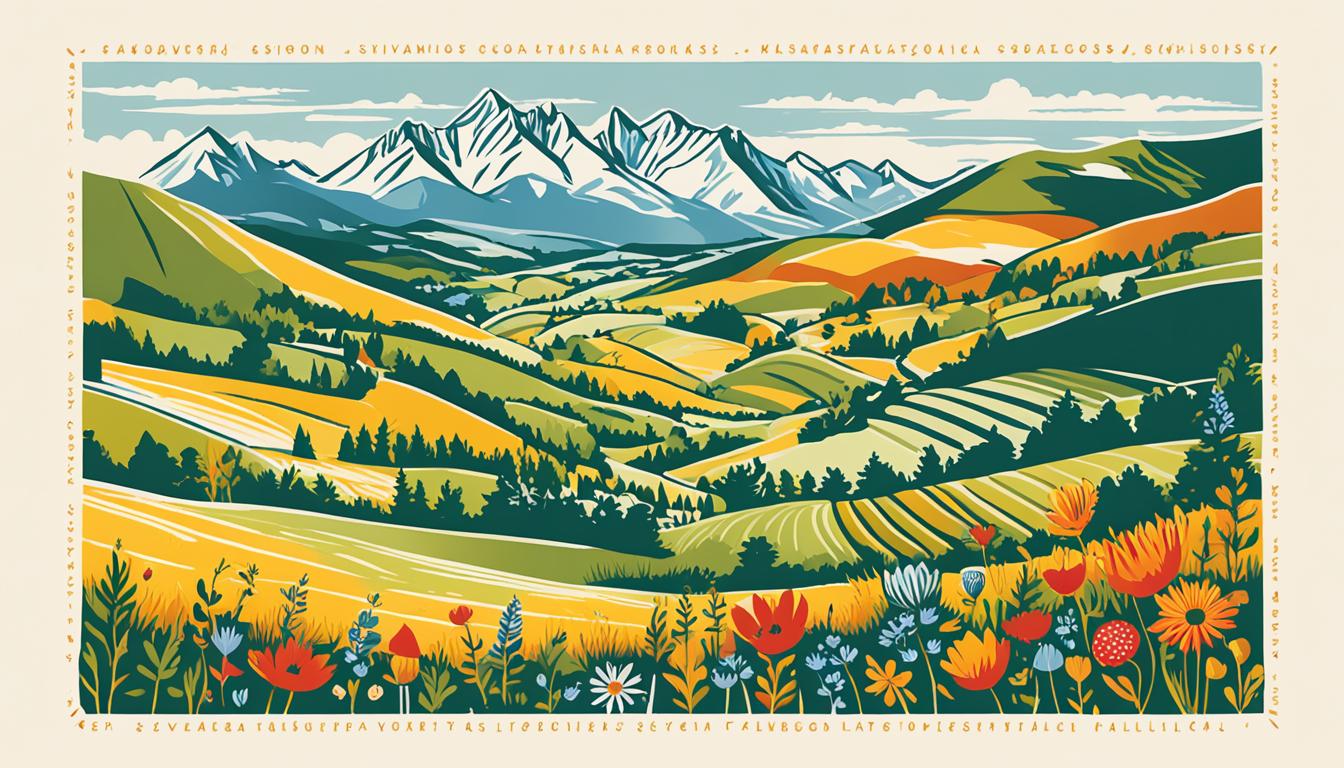Did you know that Slovakia is home to over 11,323 plant species, more than 28,800 animal species, and over 1,000 species of protozoa? This small European country nestled between the Carpathian Mountains and the Pannonian lowlands boasts an incredible diversity of flora and fauna. However, this wealth of biodiversity is facing significant threats, including habitat loss and population decline.
In this article, we will explore the status and trends of biodiversity in Slovakia, the challenges it faces, and the conservation efforts being made to protect its natural heritage. We will also delve into the cultural and spiritual significance of sacred natural sites in Slovakia and their role in biodiversity conservation.
Join us on this journey to discover the unique beauty and importance of Slovakia’s sacred natural sites and the ongoing efforts to preserve them.
Key Takeaways:
- Slovakia is home to a remarkable number of plant and animal species
- Biodiversity in Slovakia is threatened by habitat loss and population decline
- Sacred natural sites play a crucial role in biodiversity conservation
- Slovakia is implementing conservation efforts to protect its natural heritage
- Indigenous communities are actively involved in biodiversity conservation
Biodiversity Status and Trends in Slovakia
When it comes to biodiversity, Slovakia boasts a remarkable variety of flora and fauna. The country is home to more than 11,000 plant species and over 28,000 animal species, making it a true haven for nature enthusiasts and researchers alike. However, the diverse ecosystems in Slovakia face threats that have led to a decline in population size and distribution of many species, primarily due to habitat loss and the extensive use of natural resources.
Slovakia’s endangered species include fish, amphibians, reptiles, birds, and mammals, highlighting the urgent need for conservation efforts to protect these invaluable creatures. Habitats such as halophyte habitats, rocky habitats, and forests are particularly vulnerable and require special attention in order to safeguard the delicate balance of the ecosystem.
In recognition of the importance of biodiversity conservation and sustainable development, Slovakia has implemented several measures to address the challenges at hand. The country has developed a comprehensive National Biodiversity Strategy and Action Plans, which serve as guiding frameworks to protect Slovakian natural heritage and promote environmental protection in Slovakia. These strategies aim to ensure the long-term preservation of biodiversity, while facilitating a harmonious coexistence between nature and human activities.
Biodiversity Conservation Measures in Slovakia
- Establishment of protected areas: Slovakia has increased the share of protected areas from 23% to 36%, prioritizing the conservation of unique habitats and vulnerable species. The country has established national parks, nature reserves, and protected landscape areas that serve as sanctuaries for biodiversity.
- Control of invasive species: Invasive alien species pose a significant threat to native flora and fauna in Slovakia. The country has implemented projects and initiatives to control the spread of these invasive species and minimize their impact on the ecosystem.
- Promotion of sustainable development: Slovakia recognizes the importance of balancing economic development with environmental protection. The National Biodiversity Strategy and Action Plans emphasize the need for sustainable practices in sectors such as agriculture, forestry, and tourism, ensuring that human activities do not compromise the integrity and resilience of the natural habitats.
Through these conservation measures, Slovakia is committed to preserving its rich biodiversity and safeguarding its natural heritage for future generations. By actively engaging in environmental protection initiatives, the country is paving the way for a sustainable future that prioritizes the health and well-being of both nature and its people.
| Endangered Species |
Threatened Habitats |
| Fish |
Halophyte Habitats |
| Amphibians |
Rocky Habitats |
| Reptiles |
Forests |
| Birds |
|
| Mammals |
|
Threats to Biodiversity in Slovakia
In Slovakia, biodiversity faces numerous threats stemming from human activities and environmental factors. These threats, if left unchecked, can have severe consequences for indigenous land conservation, biodiversity conservation, and environmental protection in Slovakia.

Habitat fragmentation: One of the primary threats to biodiversity in Slovakia is habitat fragmentation. The construction of transport infrastructure, such as roads and railways, results in the division of natural habitats into smaller, isolated fragments. This fragmentation disrupts ecological connectivity and adversely affects the survival and movement of many species.
Reduction in arable land use: Another significant threat is the reduction in arable land use. Agricultural expansion, urbanization, and changes in land management practices contribute to the loss of fertile land, depriving various species of their natural habitats and food sources.
Invasive species: The introduction and spread of invasive alien species further exacerbate the challenges faced by native flora and fauna. These aggressive species outcompete and displace indigenous species, leading to a decline in biodiversity. The establishment of invasive species can significantly alter ecosystems and disrupt ecological balance.
Acidification of soil and water: The acidification of soil and water bodies poses a threat to biodiversity in Slovakia. Acid rain resulting from industrial pollution and emissions contributes to the acidification, which can negatively impact both terrestrial and aquatic ecosystems. Acidified soil and water can degrade plant health, limit species diversity, and harm aquatic organisms.
Climate change: Climate change poses a significant threat to biodiversity worldwide, and Slovakia is no exception. The changing climate patterns, including rising temperatures, changing precipitation patterns, and extreme weather events, disrupt ecosystems and challenge the ability of many species to adapt and survive.
Industrial pollution: Industries in Slovakia contribute to environmental pollution, releasing harmful substances and pollutants into the air, water, and soil. Industrial pollution has detrimental effects on biodiversity, contaminating habitats, diminishing water quality, and affecting the health and reproductive capabilities of plants and animals.
Mineral extraction: The extraction of minerals and natural resources can result in habitat destruction, soil erosion, and the disruption of ecosystems. Mining operations often involve the clearing of forests, leading to the loss of biodiversity-rich areas and threatening the survival of many plant and animal species.
Agricultural pollution: Agricultural practices can contribute to pollution through the excessive use of chemical fertilizers, pesticides, and herbicides. These agrochemicals can contaminate water sources, degrade soil quality, and harm non-target species, impacting biodiversity and ecosystem health.
Forestry: Although sustainable forestry practices are essential for maintaining biodiversity, unsustainable logging and deforestation can have devastating consequences. The loss of forests reduces habitat availability for many species, contributes to soil erosion, alters water cycles, and releases significant carbon dioxide into the atmosphere.
Tourism: While tourism can bring economic benefits, it can also pose a threat to biodiversity in Slovakia. Unsustainable tourism practices, including habitat disturbance, pollution, and overexploitation of natural resources, can degrade ecosystems and negatively impact local flora and fauna.
Slovakia recognizes the urgency of addressing these threats and has launched various initiatives to mitigate their impact on indigenous land conservation, biodiversity conservation, and environmental protection. Efforts aimed at controlling invasive alien species, reducing agricultural pollution, promoting sustainable practices, and raising awareness among both locals and tourists are essential for safeguarding Slovakia’s precious natural heritage.
Biodiversity Conservation Efforts in Slovakia
Slovakia is committed to biodiversity conservation and has implemented various measures to protect its natural heritage and enhance environmental protection in the country. These efforts align with the goals of the Convention on Biological Diversity, focusing on biodiversity conservation, environmental protection in Slovakia, and indigenous land conservation.
One of the key initiatives is the expansion of protected areas in Slovakia. The country has significantly increased the share of protected areas from 23% to 36% of its territory. This expansion includes the implementation of the Natura 2000 network, which aims to preserve and restore biodiversity through the conservation of natural habitats and species.
Slovakia also places great importance on its forests, which play a vital role in biodiversity conservation. The country has one of the highest levels of forestation in Europe, and the forest area continues to increase. This focus on forest conservation helps to maintain habitats for a diverse range of plant and animal species.

In addition to protected areas and forests, Slovakia has established national parks, Ramsar sites, Special Protection Areas, and approved sites in various biogeographical regions. These designated areas serve as vital habitats for numerous plant and animal species, contributing to biodiversity conservation efforts.
Recognizing the importance of controlling invasive alien species and reducing agricultural pollution, Slovakia has implemented projects aimed at addressing these issues. By managing and preventing the spread of invasive species and reducing pollution caused by agricultural practices, the country aims to protect and restore ecosystems.
Slovakia actively promotes the involvement of local and indigenous communities in biodiversity conservation efforts. The country believes that the preservation of biodiversity is closely tied to the traditional knowledge and practices of these communities. By engaging local communities in conservation activities, Slovakia ensures the sustainable use of natural resources and the preservation of cultural and spiritual values.
The country also prioritizes environmental education initiatives to raise awareness and foster a sense of responsibility towards biodiversity conservation. Through educational programs and campaigns, Slovakia aims to educate its citizens about the importance of environmental protection and the role they can play in preserving the country’s natural heritage.
| Biodiversity Conservation Efforts in Slovakia |
|
| Expansion of protected areas |
23% to 36% increase |
| Focus on forest conservation |
High level of forestation |
| Establishment of national parks, Ramsar sites, Special Protection Areas, and approved sites |
Preservation of diverse habitats |
| Projects to control invasive alien species |
Protection of ecosystems |
| Efforts to reduce agricultural pollution |
Sustainable use of natural resources |
| Involvement of local and indigenous communities |
Preservation of cultural and spiritual values |
| Environmental education initiatives |
Awareness and responsibility |
Overall, Slovakia’s biodiversity conservation efforts reflect its commitment to environmental protection, sustainable land use, and the preservation of its natural heritage. By implementing a range of initiatives and engaging various stakeholders, Slovakia aims to safeguard its biodiversity for future generations.
Support Mechanisms for Biodiversity Conservation in Slovakia
Slovakia has implemented various support mechanisms to ensure effective biodiversity conservation. These mechanisms involve collaborations across government departments, non-governmental organizations, and the private sector. By mainstreaming biodiversity into the strategies and programs of departments such as Agriculture, Economy, Education, Health, and Culture, Slovakia is able to integrate conservation efforts into various sectors of society.
Non-governmental organizations play a vital role in biodiversity conservation in Slovakia. These organizations actively participate in efforts to protect and preserve the environment, working alongside governmental institutions to ensure the success of conservation initiatives. Additionally, Slovakia cooperates with the private sector on specific issues, acknowledging the importance of a collaborative approach in achieving sustainable environmental management.
Funding plays a significant role in supporting biodiversity conservation in Slovakia. The state budget, Environmental Fund, and EU funds and programs provide financial resources to implement conservation projects and initiatives. These funds are crucial in supporting research, monitoring, habitat restoration, and other activities aimed at safeguarding the country’s rich biodiversity.

Despite the presence of support mechanisms, challenges still exist. Coordinating and maintaining consistency among different strategies and planning documents remain ongoing obstacles. Efficient coordination ensures that all stakeholders are aligned in their objectives and activities, leading to more effective and cohesive conservation efforts. Consistency among strategies and planning documents streamlines practices and ensures clarity in implementing biodiversity conservation measures.
The table below highlights some of the support mechanisms for biodiversity conservation in Slovakia:
| Support Mechanism |
Description |
| Mainstreaming Biodiversity |
Integrating biodiversity considerations into the strategies and programs of government departments, such as Agriculture, Economy, Education, Health, and Culture. |
| Collaboration with NGOs |
Involving non-governmental organizations in conservation efforts to enhance biodiversity protection and preservation. |
| Cooperation with the Private Sector |
Collaborating with businesses and industries on specific issues related to biodiversity conservation. |
| Financial Support |
Providing funding from the state budget, Environmental Fund, and EU funds and programs to support biodiversity conservation projects. |
By continuing to strengthen support mechanisms and addressing existing challenges, Slovakia can further enhance its efforts in biodiversity conservation and environmental protection.
Monitoring and Reviewing Biodiversity Conservation in Slovakia
Slovakia recognizes the importance of monitoring and reviewing the implementation of biodiversity conservation efforts. Through an established monitoring system, the country gathers valuable data on the status and trends of biodiversity. This includes information on the population sizes of various species, the condition of habitats, and the effectiveness of conservation measures.
The monitoring efforts aim to assess the success of Slovakia’s environmental protection measures and identify areas that require further attention. While specific details of the monitoring system are not readily available, it is an essential aspect of evaluating the effectiveness of ongoing conservation initiatives.
In addition to monitoring, Slovakia regularly reviews the progress of its National Biodiversity Strategy and Action Plans. These plans outline the country’s goals and actions for biodiversity conservation, and their evaluation helps ensure that they remain relevant and effective. Through these reviews, Slovakia can identify any gaps or shortcomings in its conservation efforts, leading to the development of new strategies and adjustments to existing ones.
However, Slovakia faces ongoing challenges in terms of cooperation and coordination at all levels of activity. To achieve effective monitoring and reviews, it is crucial to have strong collaboration among government agencies, environmental organizations, and local communities. Furthermore, the consistency and alignment of different strategies and planning documents need to be improved to enhance the overall effectiveness of biodiversity conservation in the country.
Monitoring and Reviewing Challenges:
- Inconsistent cooperation and coordination among stakeholders.
- Varying levels of engagement and commitment from different government departments.
- Lack of uniformity and alignment among various conservation strategies and planning documents.
Addressing these challenges will require continuous efforts to improve communication and collaboration between stakeholders, as well as the establishment of robust mechanisms for regular review and evaluation. By working together, Slovakia can optimize its monitoring and reviewing processes, effectively track the progress of its conservation initiatives, and make informed decisions to protect its valuable biodiversity resources.

Biodiversity Monitoring and Review Status in Slovakia
| Monitoring and Review Aspect |
Status |
| Implementation of monitoring system |
Ongoing |
| Evaluation of National Biodiversity Strategy and Action Plans |
Regularly reviewed |
| Cooperation and coordination among stakeholders |
Ongoing challenges |
| Consistency and alignment of strategies and planning documents |
Room for improvement |
Sacred Natural Sites in Slovakia
Slovakia is home to numerous sacred natural sites that hold cultural and spiritual significance. These sites are often associated with caves or tunnels and are considered holy places by local communities. The Carpathian Mountains region, in particular, has a rich history of ancient civilizations and their belief systems. Many sacred sites in Slovakia are located within National and Nature Parks, making them protected areas. These sites attract visitors from around the world who seek to connect with nature and experience the spiritual and cultural heritage of Slovakia.

Cultural Heritage and Sacred Sites in Slovakia
The sacred natural sites in Slovakia hold both ecological and cultural significance. Nestled in the Carpathian region, Slovakia is known for its diverse ethnic groups, each with their own beliefs, dialects, and ethnic identities. The region boasts a long history of ancient civilizations, such as the Geto-Dacians, who worshipped deities like Zamolxe and constructed intricate temple structures. The spiritual ecology intertwined with these sacred sites reflects the country’s rich cultural heritage.
Slovakia’s sacred natural sites are not only places of worship but also serve as reminders of the impact of historical events. Wooden churches, monasteries, and graveyards from World War I and II stand as poignant remnants, embodying the stories and struggles of past generations. These cultural elements add depth and dimension to the sacred natural sites in Slovakia.
“The spiritual ecology intertwined with these sacred sites reflects the country’s rich cultural heritage.”

Preserving History: Wooden Churches, Monasteries, and Graveyards
The historical heritage of sacred sites in Slovakia extends beyond natural landscapes. Wooden churches, characterized by their unique architecture, are prevalent in the country, particularly in regions like Orava and Liptov. These churches hold spiritual significance for the local communities and showcase exceptional craftsmanship.
Monasteries, such as the medieval monastery of Zvolen, provide a glimpse into the religious practices and traditions of the past. These sacred sites served as centers of spiritual and educational activities, shaping the historical fabric of Slovakia.
Graveyards from World War I and II further contribute to the cultural heritage of the sacred sites. They stand as solemn reminders of the sacrifices made and the impact of these global conflicts on the local communities. These sacred spaces are cherished not only as final resting places but also as significant historical landmarks.
Connecting Culture and Nature
The sacred natural sites in Slovakia create a unique fusion of culture and nature. They attract visitors from around the world, drawn to the opportunity to connect with the spiritual and cultural heritage of the country.
Visiting these sites offers a profound experience where one can immerse themselves in the beautiful landscapes while also exploring the cultural significance embedded within the surroundings. The sacred natural sites in Slovakia exemplify the harmonious relationship between humans, nature, and spirituality.
| Sacred Natural Sites |
Cultural Significance |
| The Dobšinská Ice Cave |
An important natural heritage site and a symbol of national identity |
| Pieniny National Park |
Rich folklore and traditions associated with mountain peaks, valleys, and the scenic Dunajec River Gorge |
| Slovak Karst |
Collection of caves with strong cultural ties, attracting researchers and visitors alike |
| High Tatras |
A region known for its pristine landscapes and folklore linked to mythical creatures and mountain spirits |
These sacred sites, deeply rooted in Slovakian natural heritage, inspire reverence and appreciation for both the cultural and ecological aspects of the country. They provide an opportunity for visitors to embark on a journey of spiritual discovery and foster a greater understanding of the interconnectedness between culture and nature.
Ecotourism and Sacred Natural Sites in Slovakia
The preservation of landscapes and natural ecosystems in Slovakia’s sacred natural sites is vital for the country’s competitiveness in the tourism sector. Furthermore, it plays a significant role in promoting sustainable development and conservation efforts. The unique combination of natural beauty and cultural heritage of these sacred sites appeals to tourists seeking a spiritual connection with nature.
Visitors are drawn to the serene nature sanctuaries in Slovakia, where they can immerse themselves in the tranquility of the surroundings and experience the deep spiritual ecology that these sites embody. The harmonious blend of untouched landscapes and the sacredness attached to these sites create a truly enriching experience for those who seek a deeper connection with their surroundings.
In order to support the preservation and accessibility of these sacred natural sites, Slovakia is dedicated to promoting ecotourism. By offering sustainable and responsible tourism experiences, the country aims to increase the revenue generated from active tourism. This approach not only benefits the local economies but also contributes to the conservation efforts of these nature sanctuaries.
“Ecotourism not only offers an opportunity to explore the beauty of Slovakia’s sacred natural sites but also acts as a vehicle for raising awareness about the importance of biodiversity conservation and spiritual ecology,” says Anna Novak, a sustainability advocate.
Through ecotourism, visitors have the chance to engage with the local communities who have long-standing connections to these sacred sites. Indigenous practices and traditions are respected and celebrated, allowing visitors to gain a deeper appreciation for the spiritual and cultural heritage embedded in these landscapes. The involvement of indigenous communities in ecotourism initiatives also ensures the preservation of their traditional knowledge and sustainable land management practices.
By preserving and promoting the accessibility of Slovakia’s sacred natural sites, the country not only fosters a deeper connection between visitors and the environment but also supports the conservation of its rich biodiversity. Through the harmonious blend of nature sanctuaries, spiritual ecology, and responsible tourism, Slovakia embraces a holistic approach to protect its natural heritage for future generations.

Indigenous Communities and Sacred Natural Sites in Slovakia
Indigenous communities in Slovakia, such as the Rusyns, Lemkos, Bojkos, Hutsuls, Górals, Szeklers, Csángos, and Mot¸i, have a deep connection to the sacred natural sites in the Carpathian region. These communities have developed their own beliefs, dialects, and ethnic identities over centuries of isolation.
These indigenous communities play a vital role in the conservation and preservation of the sacred sites, practicing sustainable land use and passing down traditional knowledge. Their deep understanding of the local ecosystem and spiritual connection to the land makes them invaluable guardians of these sacred places.
“We have always had a deep reverence for the land and the sacred natural sites within it. Our ancestors taught us to honor and protect these places, ensuring they remain untouched for future generations,” explains Elena, a member of the Rusyn community.
Slovakia recognizes the importance of involving local communities in biodiversity conservation efforts. The government supports projects that empower indigenous communities in maintaining their cultural and spiritual practices, thereby ensuring the preservation of sacred natural sites. This collaboration fosters a sense of ownership and responsibility among community members, leading to more effective conservation outcomes.
Preserving Traditional Practices
Indigenous communities in Slovakia have a long-standing tradition of sustainable land use and natural resource management. They possess intricate knowledge of the local environment, passed down from generation to generation. These traditional practices contribute to the overall health of ecosystems and promote the long-term sustainability of biodiversity.
“Our ancestors lived in harmony with nature, understanding that our well-being is intricately connected to the health of the land,” says Tomáš, a member of the Hutsul community. “We continue to practice ancient customs and rituals that ensure the spiritual and ecological balance of the sacred sites.”
Slovakia recognizes the significance of maintaining these traditional practices in the context of biodiversity conservation. By supporting indigenous communities and their cultural and spiritual practices, the country aims to preserve the unique harmony between nature and human existence.
Empowering Indigenous Communities
Slovakia actively promotes the involvement of indigenous communities in decision-making processes related to biodiversity conservation. Engaging community members in conservation initiatives allows for a more holistic approach that takes into account their unique perspectives, knowledge, and needs.
Through collaboration with indigenous communities, Slovakia seeks to empower these groups to become stewards of their ancestral lands. By providing support and resources, the country enables indigenous communities to actively participate in the management and protection of sacred natural sites, strengthening their sense of identity and connection to the land.
Fostering Spiritual Ecology
The preservation of sacred natural sites in Slovakia not only conserves biodiversity but also fosters spiritual ecology. These sites serve as spaces for spiritual contemplation, connecting individuals to the transcendent and deepening their relationship with nature.
“Our sacred natural sites are more than just physical places; they are portals to a higher spiritual realm,” says Kata, a member of the Csángos community. “Being in these spaces allows us to reconnect with the divine and experience a profound sense of peace and harmony.”
Slovakia recognizes the importance of spiritual ecology in the overall well-being of individuals and society. By protecting sacred natural sites and promoting their accessibility, the country seeks to support the spiritual journeys of visitors and foster a deeper connection with nature.
Future Challenges and Opportunities in Slovakia’s Biodiversity Conservation
Despite the efforts made in biodiversity conservation in Slovakia, there are ongoing challenges and opportunities for future improvements. Consistent cooperation and coordination among different strategies and planning documents are necessary to enhance implementation. Funding remains a challenge, with Slovakia no longer qualifying for GEF funding and feeling the lack of financial support. Furthermore, the country faces the task of addressing the impact of climate change and promoting sustainable practices in sectors such as agriculture and tourism. However, Slovakia has the opportunity to continue promoting its rich natural and cultural heritage through ecotourism and the involvement of local communities.
Slovakia’s biodiversity conservation efforts have seen significant progress, but further collaboration between stakeholders and comprehensive planning are essential for effective implementation. Securing funding for conservation projects remains a challenge, as the country no longer qualifies for GEF funding. This lack of financial support hampers the scaling up of conservation activities and limits the potential impact. To address these funding gaps, alternative sources such as public-private partnerships and eco-tourism initiatives can be explored.
“Conservation is a shared responsibility that requires the collective effort of governments, NGOs, and local communities. By working together, we can overcome the challenges and create sustainable solutions for the future.” – Environmental Conservation Director, Slovakia
Climate change poses a significant threat to Slovakia’s biodiversity. Rising temperatures, changing precipitation patterns, and extreme weather events can disrupt ecosystems, alter habitat conditions, and impact species’ distribution. It is crucial for Slovakia to prioritize climate change adaptation strategies and sustainable practices in sectors like agriculture and tourism. Investing in research and innovative technologies can help mitigate the environmental impact of these sectors and pave the way for sustainable development.
Slovakia has a unique opportunity to leverage its rich natural and cultural heritage to boost ecotourism. The country’s sacred natural sites, diverse ecosystems, and traditional practices attract visitors seeking immersive experiences in nature. By promoting responsible tourism practices and supporting local communities, Slovakia can generate economic benefits while conserving its biodiversity. Initiatives such as environmental education programs and community-based tourism projects can empower locals and raise awareness about the importance of protecting the environment.
Promoting Sustainable Agriculture
Agriculture plays a crucial role in Slovakia’s economy, but it can also have significant environmental impacts, including habitat loss, water pollution, and soil degradation. To ensure the long-term sustainability of agriculture, Slovakia should promote sustainable farming practices, such as organic farming, agroforestry, and precision agriculture. By adopting these methods, farmers can reduce their ecological footprint, protect biodiversity, and enhance soil health. Government subsidies and incentives can encourage farmers to transition to sustainable practices and reward them for their conservation efforts.
Enhancing Conservation Education
An informed and engaged society is essential for successful biodiversity conservation. Slovakia should invest in environmental education programs to raise awareness about the value of biodiversity and the role individuals can play in conservation. These programs can be integrated into school curricula, community workshops, and public awareness campaigns. By fostering a sense of environmental stewardship among citizens, Slovakia can create a culture of conservation that extends beyond protected areas and into everyday life.
The Role of Technology in Conservation
Advancements in technology provide innovative tools and solutions for biodiversity conservation. Slovakia can harness the power of remote sensing, data analysis, and artificial intelligence to monitor ecosystems, assess species populations, and identify conservation priorities. Partnerships with academic institutions and technology companies can facilitate the application of cutting-edge technologies in conservation efforts. By embracing technology, Slovakia can improve the efficiency and effectiveness of its biodiversity conservation strategies.
In conclusion, while Slovakia faces challenges in biodiversity conservation, there are also exciting opportunities to strengthen environmental protection in the country. By fostering collaboration, securing funding, addressing climate change, promoting ecotourism, and engaging local communities, Slovakia can ensure the preservation of its rich natural heritage for future generations.
Conclusion
Slovakia’s sacred natural sites hold incredible significance for both its biodiversity and cultural heritage. These sites attract visitors from all corners of the world, drawn by the unique blend of ecological and spiritual wonders. To safeguard this natural treasure, Slovakia has implemented a range of measures, including the establishment of protected areas and the active involvement of local and indigenous communities. These efforts have contributed to the conservation of its rich biodiversity.
However, challenges persist in the form of habitat loss, climate change, and limited funding. By promoting sustainable practices and preserving its sacred natural sites, Slovakia can continue to protect its natural heritage for generations to come. It is essential to maintain the delicate balance between conservation and development, ensuring the long-term well-being of both the environment and local communities.
Through the collective efforts of government agencies, non-governmental organizations, and individuals, Slovakia can overcome these challenges and maintain its status as a guardian of biodiversity. By capitalizing on the potential of ecotourism and further engaging indigenous communities, the country can continue to showcase its exceptional natural beauty and cultural richness. Through responsible stewardship, Slovakia can leave a lasting legacy of sustainable biodiversity conservation for future generations to value and cherish.
FAQ
What is the status of biodiversity in Slovakia?
Slovakia is home to a diverse range of flora and fauna, including over 11,000 plant species and more than 28,000 animal species. However, many species are experiencing population decline and habitat loss.
What are the main threats to biodiversity in Slovakia?
The main threats to biodiversity in Slovakia include habitat fragmentation, reduction in arable land use, invasive species, climate change, industrial pollution, and more. Aquatic and wetland species are particularly affected.
What efforts are being made to conserve biodiversity in Slovakia?
Slovakia has implemented measures such as establishing protected areas, controlling invasive species, and involving local communities in conservation efforts.
What support mechanisms are available for biodiversity conservation in Slovakia?
Slovakia incorporates biodiversity conservation into various government strategies and programs. Funding comes from the state budget, Environmental Fund, and EU funds and programs.
How is biodiversity conservation in Slovakia monitored and reviewed?
Slovakia uses an environmental monitoring system to evaluate the implementation of conservation efforts. The progress of the National Biodiversity Strategy and Action Plans is also assessed.
What are sacred natural sites in Slovakia?
Sacred natural sites in Slovakia are locations that hold cultural and spiritual significance, often associated with caves or tunnels. They are considered holy places by local communities.
What is the cultural heritage associated with sacred sites in Slovakia?
Sacred sites in Slovakia have a rich history and are associated with diverse ethnic groups, ancient civilizations, and historic structures such as wooden churches and monasteries.
How does ecotourism relate to sacred natural sites in Slovakia?
Ecotourism plays a significant role in promoting sustainable development and conservation efforts at sacred sites. These sites attract tourists seeking a spiritual connection with nature.
What role do indigenous communities play in the conservation of sacred natural sites in Slovakia?
Indigenous communities in Slovakia have a deep connection to the sacred sites and actively participate in their conservation and preservation, utilizing sustainable land use practices and traditional knowledge.
What challenges and opportunities exist for biodiversity conservation in Slovakia?
Challenges include coordination and funding limitations, while opportunities lie in promoting sustainable practices and preserving the country’s natural and cultural heritage through ecotourism and community involvement.
Source Links

























Post comments (0)